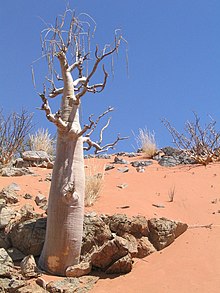Moringa (genus)
Appearance
| Moringa | |
|---|---|

| |
| M. ovalifolia in Namibia | |
| Scientific classification | |
| Kingdom: | |
| (unranked): | |
| (unranked): | |
| (unranked): | |
| Order: | |
| Family: | Moringaceae |
| Genus: | Moringa |
| Type species | |
| Moringa oleifera | |
| Species | |
|
See text | |
| Synonyms | |
|
Donaldsonia Baker f. | |
Moringa, native to parts of Africa and Asia, is the sole genus in the flowering plant family Moringaceae. The name is derived from murungai/munakkai/muringa, the Tamil/Telugu/Malayalam word for drumstick. It contains 13 species from tropical and subtropical climates that range in size from tiny herbs to massive trees.
The most widely cultivated species is Moringa oleifera, a multipurpose tree native to the foothills of the Himalayas in northwestern India[4] and cultivated throughout the tropics.[5] M. stenopetala, an African species, is also widely grown, but to a much lesser extent than M. oleifera.
Moringa species grow quickly in many types of environments.
List of species
- Moringa arborea Verdc. (indigenous to Kenya)[6]
- Moringa borziana Mattei (indigenous to Somalia)[6]
- Moringa concanensis Nimmo (indigenous to northern India)[6]
- Moringa drouhardii Jum. – bottle tree (indigenous to southwestern Madagascar)[6]
- Moringa hildebrandtii Engl. – Hildebrandt's moringa (indigenous to southwestern Madagascar)[6]
- Moringa longituba Engl. (indigenous to Ethiopia and Somalia)[6]
- Moringa oleifera Lam. (syn. M. pterygosperma) – horseradish tree (indigenous to northwestern India)[6]
- Moringa ovalifolia Dinter & Berger (indigenous to Namibia and Angola)[6]
- Moringa peregrina (Forssk.) Fiori [7] indigenous to Horn of Africa and in the Southern Sinai, Egypt[6][8]
- Moringa pygmaea Verdc. (indigenous to Somalia)[6]
- Moringa rivae Chiov. (indigenous to Kenya and Ethiopia)[6]
- Moringa ruspoliana Engl. (indigenous to Ethiopia)[6]
- Moringa stenopetala (Baker f.) Cufod.[9][10] (indigenous to Kenya and Ethiopia)[6]
References
- ^ Angiosperm Phylogeny Group (2009). "An update of the Angiosperm Phylogeny Group classification for the orders and families of flowering plants: APG III" (PDF). Botanical Journal of the Linnean Society. 161 (2): 105–121. doi:10.1111/j.1095-8339.2009.00996.x. Retrieved 2013-07-06.
- ^ a b "Genus: Moringa Adans". Germplasm Resources Information Network. United States Department of Agriculture. 1996-09-17. Retrieved 2011-09-26.
- ^ "Moringa Adans". TROPICOS. Missouri Botanical Garden. Retrieved 2009-12-30.
- ^ Olson, Mark (2010). "Moringaceae Martinov. Drumstick Tree Family" (PDF). Flora of North America. 1993+. Flora of North America North of Mexico. 7: 167–169.
- ^ Janick, Jules; Robert E. Paull (2008). The Encyclopedia of Fruit & Nuts. CABI. pp. 509–510. ISBN 978-0-85199-638-7.
- ^ a b c d e f g h i j k l m Leone A, Spada A, Battezzati A, Schiraldi A, Aristil J, Bertoli S (2015). "Cultivation, Genetic, Ethnopharmacology, Phytochemistry and Pharmacology of Moringa oleifera Leaves: An Overview". International Journal of Molecular Sciences. 16: 12791–12835. doi:10.3390/ijms160612791.
{{cite journal}}: CS1 maint: unflagged free DOI (link) - ^ Dadamouny, M.A. (2009). "Population Ecology of Moringa peregrina growing in Southern Sinai, Egypt". M.Sc. Suez Canal University, Faculty of Science, Botany Department. Retrieved 2009-12-26.
{{cite web}}: CS1 maint: numeric names: authors list (link) - ^ Dadamouny, M.A., Unterseher, M., König, P., & Schnittler, M. (2016). "Population performance of Moringa peregrina (Forssk.) Fiori (Moringaceae) at Sinai Peninsula, Egypt in the last decades: Consequences for its conservation". Journal for nature conservation. doi:10.1016/j.jnc.2016.08.005.
{{cite web}}: CS1 maint: multiple names: authors list (link) CS1 maint: numeric names: authors list (link) - ^ "Subordinate Taxa of Moringa Adans". TROPICOS. Missouri Botanical Garden. Retrieved 2009-12-30.
- ^ Dadamouny, M.A., Zaghloul, M.S., & Moustafa, A.A. (2012). "Impact of Improved Soil Properties on Establishment of Moringa peregrina seedlings and trial to decrease its Mortality Rate". Case Study. Egyptian Journal of Botany, NIDOC. Retrieved 2012-07-03.
{{cite web}}: CS1 maint: multiple names: authors list (link) CS1 maint: numeric names: authors list (link)
External links
Wikimedia Commons has media related to Moringa.
Wikispecies has information related to Moringa (genus).
- Moringa Home Page, Instituto de Biología, Universidad Nacional Autónoma de México
- The International Moringa Germplasm Collection
